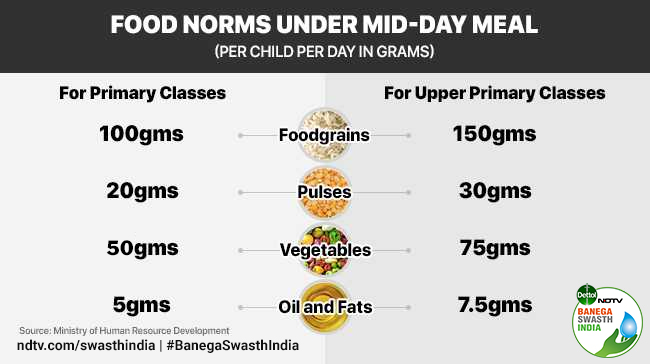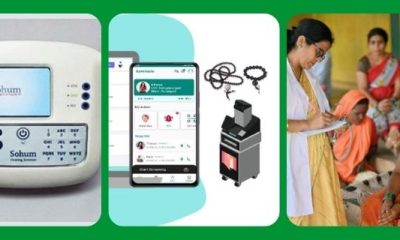New Delhi: Nutrition Support to Primary Education Scheme popularly referred to as Mid-Day Meal programme (MDM) was launched in 1995. According to Deepa Anand, Deputy Secretary, Ministry of Human Resource Development (MHRD), MDM is considered as the largest school feeding programme in the world. There are about 20.8 crore primary and upper primary school children (6-14 years) in India, as per the Population Census, 2011 which forms about 17.2 per cent of the total population of the country. The United Nations estimates that four out of 10 children in India are not meeting their full human potential because of chronic undernutrition. The MDM scheme was introduced to overcome this and protect the nutritional rights of children, said Ms. Anand.
As India moves towards fulfilling the target of eradicating malnutrition from the country and contributing to the second goal of Sustainable Development Goals (SDGs) to end all forms of hunger and malnutrition, here is a quick lowdown of things to know about the mid-day meal scheme of the country:
History Of Mid-Day Meal Programme
The concept of providing meals to students was first introduced in 1925 in India and Tamil Nadu was the first state in India to introduce a noon meal programme in primary schools followed by Gujarat, Kerala and other states. Later it was taken up as a national scheme called Nutrition Support to Primary Education Scheme or Mid-Day Meal programme which was launched on August 15, 1995, in 2,408 blocks across the country for providing one meal per day to students in primary school (Class I to V).
Implemented by the MHRD in the centre and departments like education department or women and child development department or the Panchayati Raj department in states, the scheme was made universal in all public schools in 2001 after the Supreme Court’s directions dated November 28 of the same year. The scope scheme was extended to cover the students of Upper Primary (Class VI to VIII) in 2007.
Objective Of Mid-Day Meal Programme
The key objective of the MDM is to address the issues of hunger and education in schools by serving hot cooked meals. It also aims to improve the nutritional status of children and improve enrollment, attendance and retention rates in schools and other education centres.
Who is the target beneficiary of Mid-Day Meal Programme?
According to MDM Scheme every child studying in primary and upper primary classes in government schools and government-aided schools like Alternative and Innovative Education (AIE) centres and Madrasas will get free lunch. The Supreme Court, in its direction to all states in 2001 said,
Every child in every government and government-assisted school should be given a prepared midday meal.
Another order of Supreme Court, dated April 20, 2004, directed the states to provide mid-day meals during summer vacations as well in the drought affected areas.
According to the MHRD data, about 9.12 crore children benefited from MDM across 11.35 Lakh schools across the country.
Prescribed nutritional content per meal per child
The Mid-Day Meal Guidelines ensure that the meal is designed in such a way that children get sufficient amount of proteins, carbohydrates, as well as micronutrients, such as iron and folic acid. The aim is to aid in the physical growth and cognitive development of children. The meal comprises cooked rice or wheat (depending on the local staple), mixed with lentils or jaggery, and supplemented with oil, vegetables, fruits, nuts, eggs or dessert at the local level.
According to MHRD, the children in primary school must be provided with at least 450 calories with 12 grams of protein through MDM while the children in upper primary schools get 700 calories with 20 grams of protein.
The children of primary classes are entitled to 100 grams of foodgrains, 20 grams of pulses, 50 grams of vegetables and 5 grams of oils and fats. The children of upper-primary schools, on the other hand, are entitled to get 150 grams of foodgrains, 30 grams of pulses,7 5 grams of vegetables and 7.5 grams of oils and fats.
Also Read: National Nutrition Month: The Food Superstars
Is there a Correlation between Mid-Day Meals and Learning Outcomes?
According to Elementary and Social Education Professor Anita Rampal, at the Department of Education, University of Delhi, mid-day meal programme has a positive impact on the learning outcomes. She said that children tend to attend school more where mid-day meal is being served. She asserted,
Our experience has been that children belonging to disadvantaged sections receiving school lunches are better at reading and math skills than the children not having mid-day meals.
What are the infrastructural provisions under the Mid-Day Meal Programme?
According to the MDM norms, there has to be one helper/cook up to 25 children, two helpers up to 26-100 children. One extra helper with every addition of 100 children. Each cook/helper is given an honorarium of Rs. 1000 per month. The required infrastructure includes, a kitchen shed, cooking and serving utensils, cooking stoves and cooking fuel.
Also Read: Public Interest Litigation In Supreme Court For Community Kitchens In All States To Combat Hunger
What is the Cooking cost per child per meal?
According to MHRD’s notice, dated June 24, 2019, the current cooking cost per child per day is Rs. 4.48 for primary and Rs. 6.71 for upper primary children.
Budget allocation for the Mid-Day Meal Programme
Currently, in the year 2019-20, MDM is Rs. 11,000 crore scheme which is about Rs. 500 crore more than the budget allocated in the year 2018-19. In the current year, so far about Rs. 2,322.32 crore has been released by the centre. While the budget allocation for MDM saw a steep decline from Rs. 13,215 crore in 2014-15 to Rs. 9,236.40 crore in 2015-16, the allocation has been annually since 2016-17.
What is the Contribution of Centre and State?
While the implementation of the scheme rests with the state government, MDM is a centrally-sponsored scheme which implies that the central government provides more financial assistance for running the scheme than the contribution of the state governments. In most states centre’s share is 60 per cent while the state’s share is 40 per cent. In northeast and other special states, the contribution is 90 per cent and 10 per cent respectively and the scheme is funded 100 per cent by the central government in all union territories, as per Ms. Anand.
Apart from financial assistance, central government also encourages the states and UTs to procure foodgrains grown locally for local taste and nutritional value from the central government buffer stock created by it.
Private Participation in the implementation of the programme
The implementation of MDM is supported by some non-governmental organisations (NGOs) in various states under the public-private partnership with state government, for example, Akshaya Patra Foundation which is helping in running the scheme in 12 states, Annamrita, Nandi organisation, and ISKON among others. As per Ms. Deepa Anand, the states can partner with NGOs but the important thing to focus on is to provide fresh and hot meal to children.





















